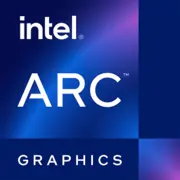Intel Arctic Sound 2T

The Intel Arctic Sound 2T GPU is a professional-grade graphics processing unit, designed to deliver high performance for a variety of intensive tasks. With a massive 16GB of HBM2e memory and a memory clock of 1200MHz, this GPU is well-equipped to handle large datasets and complex computations with ease.
One of the most notable features of the Arctic Sound 2T is its staggering 7680 shading units, allowing for incredibly detailed and realistic visual renderings. The inclusion of 8MB of L2 cache further enhances the GPU's ability to handle demanding workloads efficiently.
With a TDP of 500W, the Arctic Sound 2T is a power-hungry GPU that requires robust cooling and power supply solutions. However, this high power consumption is justified by the GPU's theoretical performance of 13.82 TFLOPS, making it a formidable choice for demanding professional applications such as 3D rendering, scientific simulations, and artificial intelligence training.
In terms of real-world performance, the Arctic Sound 2T excels in handling complex visualizations and computationally intensive tasks, delivering smooth and responsive performance even under heavy workloads. Its generous memory size and high memory bandwidth make it well-suited for handling large, high-resolution datasets, making it an ideal choice for professional content creation and scientific research.
Overall, the Intel Arctic Sound 2T GPU is an impressive piece of hardware that offers exceptional performance for professional users who require high computational power and visualization capabilities. While its power requirements may be a consideration for some users, its substantial performance capabilities make it a worthy investment for those in need of a high-powered, professional-grade GPU.
Basic
Label Name
Intel
Platform
Professional
Launch Date
January 2021
Model Name
Arctic Sound 2T
Generation
Xe Graphics
Bus Interface
PCIe 4.0 x16
Transistors
8,000 million
TMUs
?
Texture Mapping Units (TMUs) serve as components of the GPU, which are capable of rotating, scaling, and distorting binary images, and then placing them as textures onto any plane of a given 3D model. This process is called texture mapping.
240
Foundry
Intel
Process Size
10 nm
Architecture
Generation 12.5
Memory Specifications
Memory Size
16GB
Memory Type
HBM2e
Memory Bus
?
The memory bus width refers to the number of bits of data that the video memory can transfer within a single clock cycle. The larger the bus width, the greater the amount of data that can be transmitted instantaneously, making it one of the crucial parameters of video memory. The memory bandwidth is calculated as: Memory Bandwidth = Memory Frequency x Memory Bus Width / 8. Therefore, when the memory frequencies are similar, the memory bus width will determine the size of the memory bandwidth.
4096bit
Memory Clock
1200MHz
Bandwidth
?
Memory bandwidth refers to the data transfer rate between the graphics chip and the video memory. It is measured in bytes per second, and the formula to calculate it is: memory bandwidth = working frequency × memory bus width / 8 bits.
1229 GB/s
Theoretical Performance
Pixel Rate
?
Pixel fill rate refers to the number of pixels a graphics processing unit (GPU) can render per second, measured in MPixels/s (million pixels per second) or GPixels/s (billion pixels per second). It is the most commonly used metric to evaluate the pixel processing performance of a graphics card.
108.0 GPixel/s
Texture Rate
?
Texture fill rate refers to the number of texture map elements (texels) that a GPU can map to pixels in a single second.
216.0 GTexel/s
FP16 (half)
?
An important metric for measuring GPU performance is floating-point computing capability. Half-precision floating-point numbers (16-bit) are used for applications like machine learning, where lower precision is acceptable. Single-precision floating-point numbers (32-bit) are used for common multimedia and graphics processing tasks, while double-precision floating-point numbers (64-bit) are required for scientific computing that demands a wide numeric range and high accuracy.
27.65 TFLOPS
FP64 (double)
?
An important metric for measuring GPU performance is floating-point computing capability. Double-precision floating-point numbers (64-bit) are required for scientific computing that demands a wide numeric range and high accuracy, while single-precision floating-point numbers (32-bit) are used for common multimedia and graphics processing tasks. Half-precision floating-point numbers (16-bit) are used for applications like machine learning, where lower precision is acceptable.
3.456 TFLOPS
FP32 (float)
?
An important metric for measuring GPU performance is floating-point computing capability. Single-precision floating-point numbers (32-bit) are used for common multimedia and graphics processing tasks, while double-precision floating-point numbers (64-bit) are required for scientific computing that demands a wide numeric range and high accuracy. Half-precision floating-point numbers (16-bit) are used for applications like machine learning, where lower precision is acceptable.
13.544
TFLOPS
Miscellaneous
Shading Units
?
The most fundamental processing unit is the Streaming Processor (SP), where specific instructions and tasks are executed. GPUs perform parallel computing, which means multiple SPs work simultaneously to process tasks.
7680
L2 Cache
8MB
TDP
500W
Vulkan Version
?
Vulkan is a cross-platform graphics and compute API by Khronos Group, offering high performance and low CPU overhead. It lets developers control the GPU directly, reduces rendering overhead, and supports multi-threading and multi-core processors.
N/A
OpenCL Version
3.0
OpenGL
4.6
DirectX
12 (12_1)
Power Connectors
None
Shader Model
6.5
ROPs
?
The Raster Operations Pipeline (ROPs) is primarily responsible for handling lighting and reflection calculations in games, as well as managing effects like anti-aliasing (AA), high resolution, smoke, and fire. The more demanding the anti-aliasing and lighting effects in a game, the higher the performance requirements for the ROPs; otherwise, it may result in a sharp drop in frame rate.
120
Suggested PSU
900W
Benchmarks
FP32 (float)
Score
13.544
TFLOPS
Compared to Other GPU
FP32 (float)
/ TFLOPS
Share in social media
Or Link To Us
<a href="https://cputronic.com/gpu/intel-arctic-sound-2t" target="_blank">Intel Arctic Sound 2T</a>